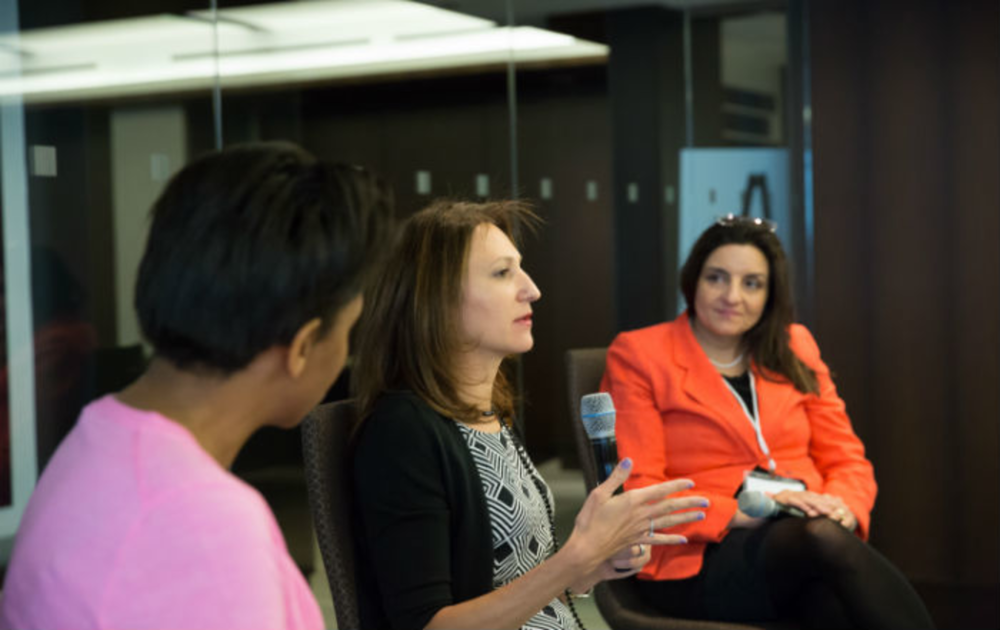The old saw, “the more things change, the more they stay the same,” is a perfect way to describe the career journey many women encounter in the marketing arena, circa 2016. Although women are taking over top positions within the industry, they’re also still subject to gender bias—in terms of pay, opportunity, and perception.
That doesn’t mean that women aren’t breaking down barriers and achieving great success. They are, as evidenced by DMN‘s Marketing Hall of Femme honorees present and previous. But much of what happens going forward depends on women opening doors for other women, and offering a helping hand whenever they can.
That was the overarching theme of the session, “Female Leadership: Being a Woman in Marketing,” held as part of the Direct Marketing News 2016 Marketing Hall of Femme Leadership Summit & Awards in New York.
The two panelists for that session are stellar examples of the success that can be achieved: Michelle Bottomley (above, right) is senior partner and chief marketing and sales officer at Mercer, as well as a past Marketing Hall of Femme honoree, and Romy Newman (above, center) is cofounder of Fairygodboss, a site launched last year to “improve the workplace for women by creating transparency.”
Acknowledging gender bias in the workplace, they offered several strategies to get ahead.
Tackling stereotypes of women in leadership positions—e.g., the use of the word “bossy” to describe female leaders—Bottomley emphasized that while it’s important to be a strong leader and have a point of view, there’s a line between having a point of view and being bossy. “It’s about being careful how you come across,” she said. As a leader, “it’s not about you; it’s about bringing people together.”
Added Newman, “When you’re a leader, you can’t worry about what people are saying. You just have to have a thick skin and do your best. Also, focus on the right things. As a manager I focus on my people, that I have the team I want, and they’re getting what they need. If you have your team’s loyalty and trust, what the rest of the company thinks doesn’t matter.”
Caring for your personal brand is critical, Bottomley said. “Look at the decisions you make and what the impact will be. How do you want your leadership to show up in the workplace? I’m tough on problems but not on people; I encourage collaboration. I think about the space I want to create around me.”
Within the workplace today it’s essential to be more personable, Newman recommended. Because women are much more fastidious and need to have “every little ‘t’ crossed,” they leave themselves little spare time, so they may not stop for those important interpersonal moments like a chat in the hallway. Perceived as standoffish, the reality is “we are just incredibly busy,” she said.
The takeaway: A few minutes of small talk goes a long way toward building a positive perception.
Diving into the equal pay conundrum, moderator Natasha D. Smith, a senior editor at Direct Marketing News, asked why millennial women are near pay parity, while older women face a widening salary gap.
“Mercer has done a lot of work on this,” Bottomley stated. “What we’ve found is that the disparity in compensation happens when women have babies.”
The reasons are twofold: First, there is unconscious bias. There is an assumption made by the powers that be that women with young children can’t handle a big project, a project that may very well be career-defining, denying women the opportunity to shine.
The second reason: women sometimes trade off career progression for work-life balance.
“It doesn’t have to be one or the other,” Bottomley insisted. “It’s up to us to make sure that women get these opportunities.”
Newman spoke to the aha moment when female executives notice gender disparity in the workplace. “You’re sailing along and feeling equitable, but the higher up you go in the organization, the thinner the air gets,” she said. “So, while women may have 100 colleagues at the bottom [of the pyramid], at the top, there may be one. Women feel the pressure in the higher ranks.”
Speaking to that pressure, Bottomley added, “As a woman, your fellow employees are watching what you do, what you wear, what you say; you have a greater responsibility to represent and set an example. I also strongly believe you have a responsibility to be a mentor and make time for junior women; they’re desperate for mentors and there aren’t very women at the top.”






